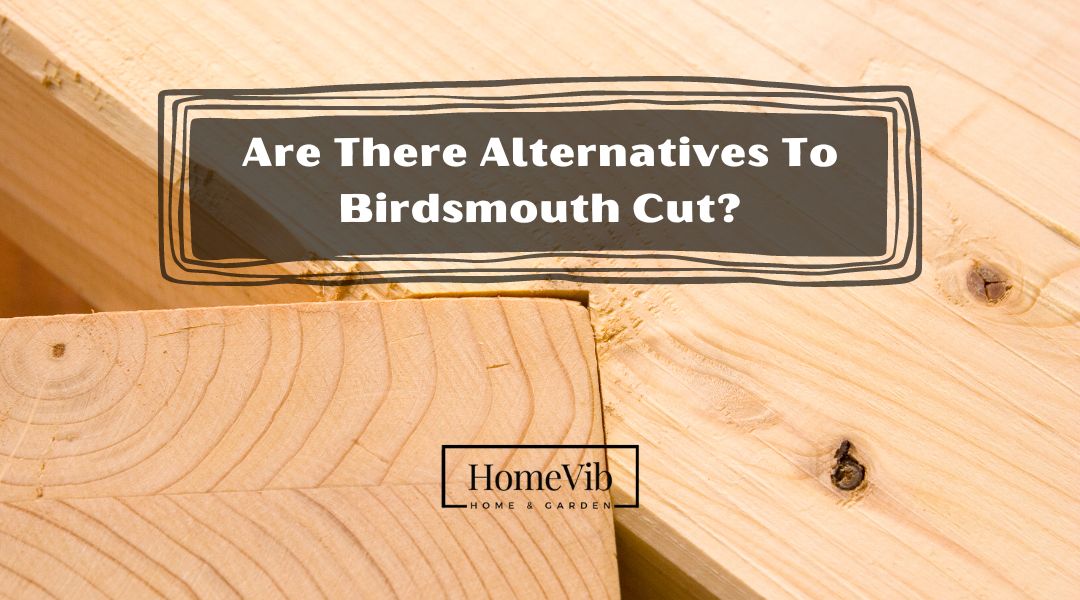The rafter cut is vital in installing a roof to a closed space such as your home, cabin, or shed. A birdsmouth is a triangular cut at the bottom of the room’s rafters. It reinforces the support as the roof rests on top of a foundation.
This type of rafter cut is the most popular because it provides better support to the frames of the roof. However, it’s challenging to make because the thinnest part of the cut could break down if you cannot do it properly.
So what are the best alternatives to a birdsmouth cut?
The recommended alternatives include hurricane ties, rafter ties, stud cutting, and variable pitch connectors.
Today, I will discuss the specifics of these rafter-cut alternatives and their ideal circumstances.
What Are The Alternatives To Birdsmouth Cut?
Below are the best alternatives to birdsmouth cut that you can try and secure the rafters to prevent them from collapsing.
Galvanized Metal Connectors (Hurricane Ties)
One of the best options aside from a birdsmouth cut is hurricane ties or galvanized metal connectors. This type of rafter support should be stronger than a birdsmouth cut. It reinforces the frame with bolts, screws, and nails to balance the weight of the entire structure.
And as the name suggests, a galvanized metal connector should be strong enough to withstand a hurricane. Such a claim is also why some references to hurricane ties are as hurricane strips or straps.
The bolts or other metal joints are highly reliable in supporting the mass of the beams. And this is an excellent choice for a certain environment with a harsh weather system and frequent strong winds. Adding metal materials should be sufficient to prevent the forces of strong winds.
Rafter Ties
Rafter ties involve constructing two opposing frames that should effectively manage the tensions coming from the main structure. In addition, they are among the best alternatives because the joist of the entire frame does not protrude.
You can strengthen the rafter’s support and improve the structure’s overall integrity by using a traditional rafter’s tie to prevent the roof installation from caving in. The structure’s integrity makes them ideal for small homes, sheds, or garages.
To increase the level of fortification, you can add a metal framing to support the entire weight and prevent the rafter from collapsing. Thus, the metal frame holds things together when maintaining the balance of the roof’s weight.
Lastly, you must measure the roof pitch before installing them. In this way, you will be able to install them properly.
Stud Cutting
A stud cut is a process by which a long rod is cut into smaller pieces to balance the entire structure. Therefore, you must take note of the measurement as accurately as possible because they will handle the tension.
And without accurate measurements, it will be difficult for the studs to support the weight of the newly installed roof. In addition, you can enhance the structural integrity of the roof’s balance when you use studs with pitch connectors to add extra support.
The good news is that stud cutting is also easier than a birdsmouth cut, especially if you use a power saw to cut the measurements. And to maximize the support strength even further, you can also add HCP on the four corners to help the studs manage the tensions.
Variable Pitch Connectors (VPAs)
Like hurricane ties, variable pitch connectors use galvanized to reinforce the structure’s integrity. It can be an excellent alternative to birdsmouth because they are more durable. VPAs are excellent for medium to large size homes due to their reliability. It attaches the top wall plate to the joist, supporting the entire structure’s weight.
In installing VPAs, you need to attach the VPAs to the rafters so they will perfectly connect to the walls to improve stability.
In addition, you may also have to install HPCs or hip corner plates along with the VPAs that will allow the even distribution of the weight and improve durability.
However, variable pitch connectors have their limitations. And the notable limitation is that the design of the VPA is suitable for roofs with slopes between 12:2 and 13:2.
However, it is still a tolerable setup if you are not particularly fond of using a birdsmouth cut.
Should I Choose Alternatives To Birdsmouth Cut?
Birdsmouth cut is the most popular way to hang the rafter. But it is not necessary to conform to the trend of birdsmouth cut.
It has an advantage over other cuts, some prominent example is that the beak-shaped cut is simple, yet it makes perfect connections to the walls. It can safely keep the rafter’s horizontal position from collapsing.
The simple process of birdsmouth cutting makes them a popular option among homeowners. But the truth is that it is not the safest since wood is susceptible to wear and tear if frequent exposure to humidity is inevitable.
In addition, although the process is simple, making a birdsmouth cut can be inconvenient sometimes. You must be careful in creating the beak-shaped cut because the wrong measurement could break the wood’s thinnest part once the pressure application becomes present.
Suppose you are unwilling to go through the inconveniences of a birdsmouth cut. You can use alternatives like variable pitch connectors, stud cutting, galvanized metal connectors, and rafter ties.
How to Decide Which Is The Best Alternative To Birdsmouth Cut?
The main factor that you have to note in choosing the best alternative to birdsmouth cut. First and foremost, you must consider the home’s size and the environment. For example, the rafter ties and stud cutting are not good options for an environment with strong winds.
And this is because they are unreliable against such conditions and can fall apart. Therefore, they can be more appropriate for small homesteads, garages, or sheds.
On the other hand, variable-pitch connectors and galvanized metal connectors are suitable for larger homes because of the presence of metal. It is more reliable against strong winds and other harsh weather systems.
Can I Use a Truss Clip Instead Of a Birdsmouth?

The purpose of a truss clip is to hold the studs and keep them from wobbling. It ensures that they won’t collapse. The overall design takes away the need for making a birdsmouth cut.
The truss clip alone prevents the entire roof structure from spreading.









